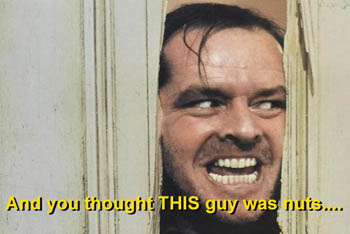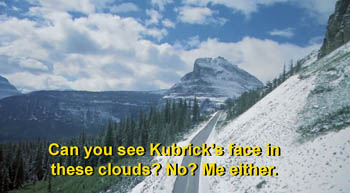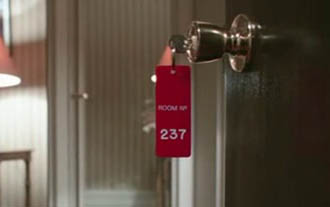|
I am veritably slack-jawed with sheer bewilderment. I've just sat through 102 minutes of this purported documentary and I'm not at all certain what I'm meant to take from it. I know what I do take from it, but I have no idea if it was what the filmmakers intended. 
For those who don't know, "room 237" refers to the most haunted room in the Overlook Hotel, from Stanley Kubrick's The Shining (and technically from Stephen King's novel, as well, though the book plays no part in the discussions herein). Neither, it must be said, does any sort of reasoned, cogent analysis. I had heard many times of the far-reaching, often barking mad theories that had grown up around this film, but here, for the first time, they're given an apparently respectable platform from which to speak. There are five presenters, who never appear onscreen, each unspooling a convoluted analysis of what they think The Shining is really about, intercut with scenes from the film and others in Kubrick's filmography (sometimes digitally retouched to include Shining references). While admittedly talking heads are pretty boring, so is seeing the same handful of clips from the film over and over (the film's opening shot is seen a dozen times or so, along with a stock shot of a projector beaming out into an apparently smoky theater). Perhaps the speakers were using pseudonyms, and were concerned that friends and family would laugh at them if their identities were known. I dare say they should be. 
For the better part of two hours, these five analysts studiously avoid any mention of the film's actual plot and instead attempt to ferret meaning out of tiny details, many of them certainly meaningless or accidental (such as the disappearance and then reappearance of a chair, much like the disappearing barrels in The Two Towers, only with deep, grafted-on significance); it's a grand example of what Roger Ebert described as the crucial difference between what ideas you find in a film, and what ideas you bring to it. Depending on who you're listening to at the moment, the film might be about the genocide of the American Indian (based on hotel decor, a can of baking soda and one passing reference to a burial ground), the Holocaust (based on the alleged reccurrence of the number 42, meaning 1942 and the only thing that happened that year, and Jack's German typewriter), the Greek myth of the labyrinth (a seemingly reasonable concept that almost totally ignores the actual maze present in the film and instead focuses on the fact that the hotel sets don't join up like a proper building would, and a supposed minotaur seen skiing in a background poster bearing the caption "ski monarch," which as we all know was what the minotaur was called by his close pals), or something really loopy. A man named Jay Weidner, almost certainly the buggiest of the bunch, starts by seeing sexual symbolism in odd places, such as an overlap between the hotel manager and a paper tray that looks, to him at least, as if the manager is sporting a giant boner for Jack Nicholson (the fact that his female secratary, mere seconds later, appears to sport the same "boner" is not mentioned). From this, he moves onto the completely batshit notion that Kubrick made the film about his own inner torment over having-let me just take a deep breath here-faked the Apollo 11 moon landing footage. Never mind that Kubrick's moon scenes in 2001 didn't look like the actual moon surface, never mind that he equivocates by saying he does believe we did make the moon trip (without explaining why we would then fake footage we could totally film for real), never mind that what he labels the "moon room" he previously said was a symbol of human sperm, not known for their abundance on the moon. Never mind all that. It's the small shit. 
Weidner's premise hangs on a thread so thin it simply isn't there. The long-understood explanation for why the haunted room was changed to 237 from its book number of 217 is that the Timberline Lodge didn't want to spook people from booking their own room 217, whereas they had no room 237. Weidner asserts that if one inquires of the Timberline Lodge itself, they will disavow having a room 217 either, meaning the choice of number 237 must therefore represent something else. To him, it's that the average distance from the Earth to the moon is 237,000 miles. There are two problems here: the average distance to the moon is closer to 239,000 miles, and more pointedly, I did contact the Timberline, and they responded as follows: Hello Mr. Murray, This illustrates a common problem encountered when attempting to explain away strange claims-often, the claim requires no explanation. It simply isn't true. (It also demonstrates, humorously, that the lodge might have done better business if they'd kept it as 217.) 
All of these analyses are presented with no rebuttals or counter-arguments by saner individuals. It's tempting to think that the filmmakers were just giving the theorists the rope from which they could simply get on with hanging themselves, but for the fact that every once in a while, one of them will make an observation that might well have some bit of merit. The fact is, The Shining is an odd film, full of ambiguities and unexplained events. There's the odd fact of the two Gradys: the former caretaker, Charles Grady, who killed his family in the early 1970s, and the apparent ghost of a Delbert Grady, who appears to have the same history of family violence but who is seemingly a relic of the 1920s ball frequently referenced in the story. There is the mysterious final shot of Jack himself at the same-said ball, there's the inconstant topology of the hedge maze (particularly in the overhead, Jack's-eye view where it is suddenly vastly larger than before), and the never-quite-resolved matter of whether the hotel is truly haunted, or whether its occupants are simply suffering mental breakdowns. There is much in the way of intelligent and thoughtful speculation that could be brought to bear on this film, but don't expect to find it here. 
It is, I confess, entertaining in its own way to see apophenia run amok. "Apophenia" is the psychological dysfunction of exaggerated, faulty pattern-recognition. Science historian Michael Shermer of the Skeptics Society has posited that such tendencies are a by-product of evolutionary selection, where a generally harmless false positive (eg. thinking you see a bear behind the hedge when there isn't one) is more likely to be passed onto future generations than a potentially disastrous false negative (eg. failing to recognize the silhouette of a bear that really is there). As the participants here completely fail to address the film's unequivocal portrait of the horrors of domestic violence in favor of wild flights of fancy, we ultimately learn far more about them than we do about the film. For a telling example, there is the aforementioned "moon room" claim, where Weidner notes that the text on the key to room 237 ("ROOM No 237"), with its use of all caps but for the "o," can only spell out "room" or "moon" if one puts all of the capital letters into play. Actually, this isn't true. The only word which uses all of the letters without reusing any is "moron." Analyze that, bitches. -review by Matt Murray
|
|
||||||||